
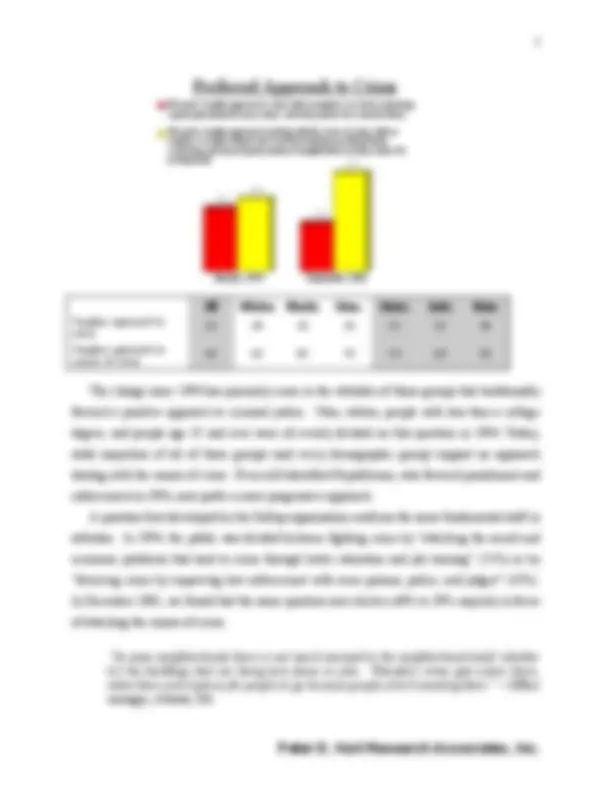
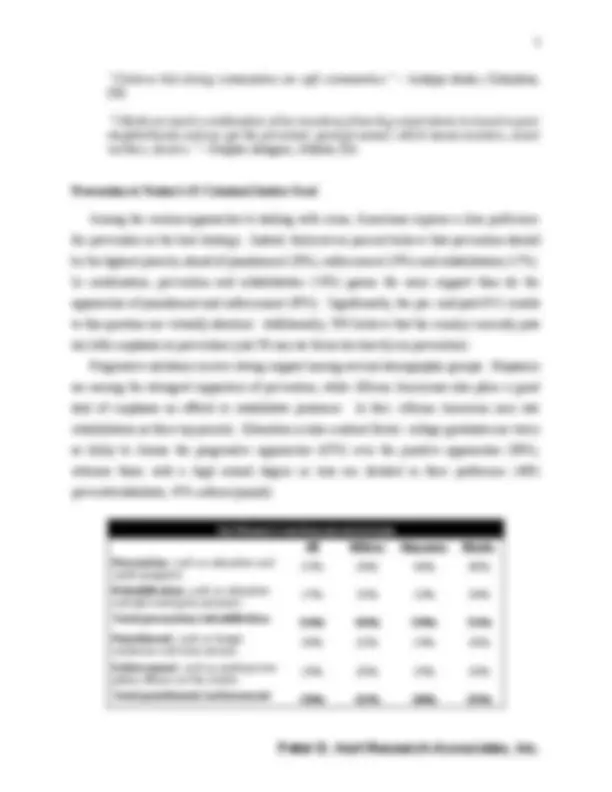

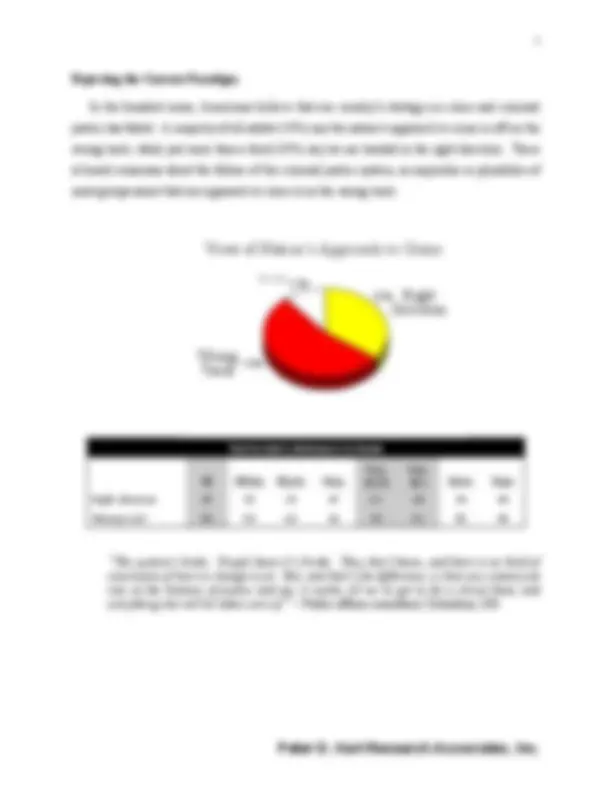
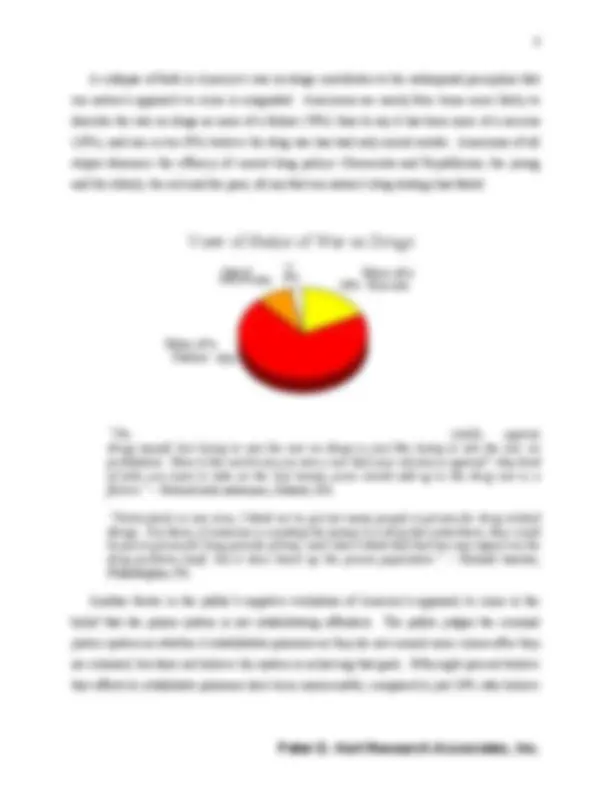

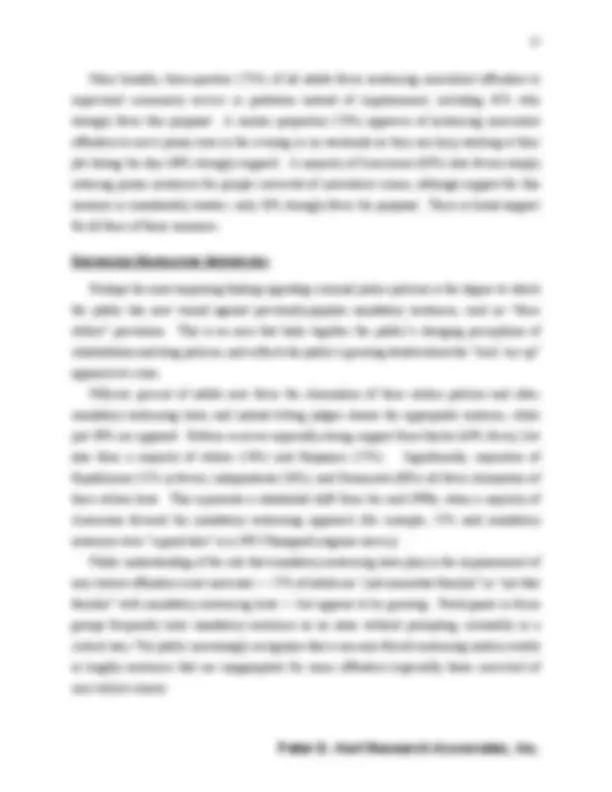
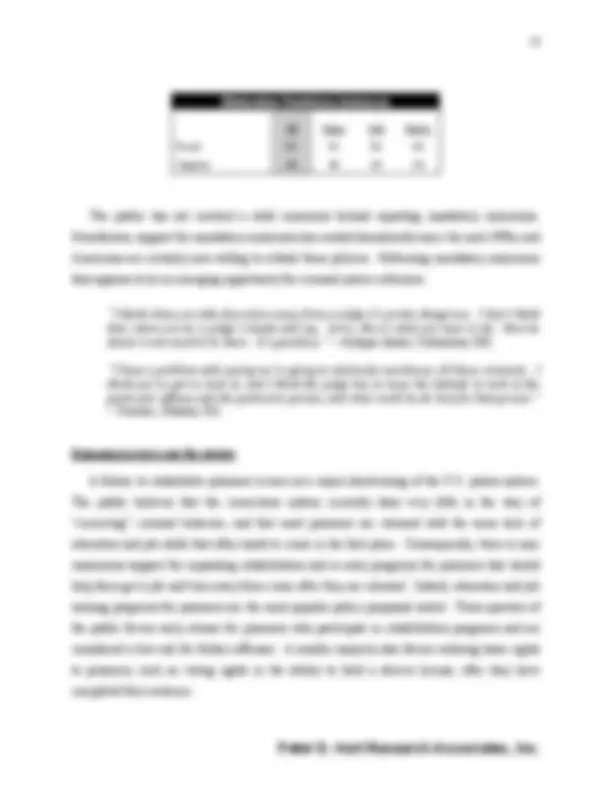
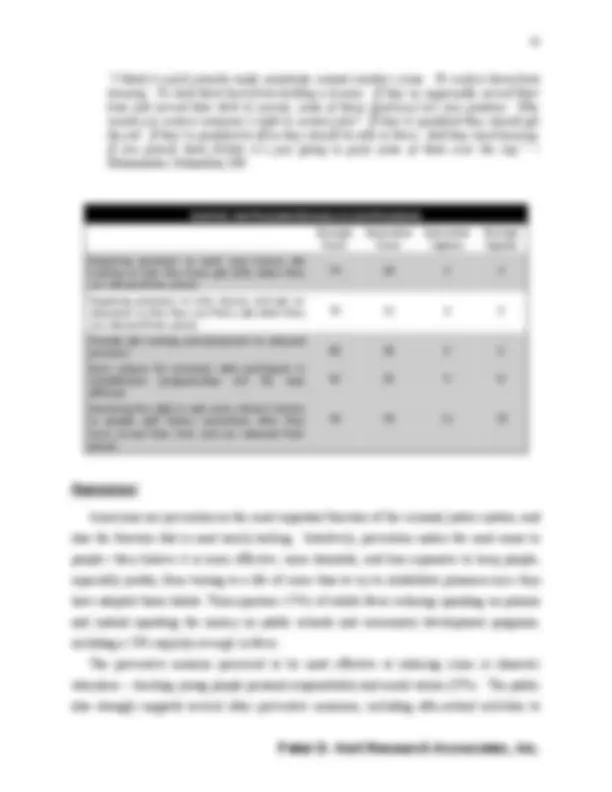
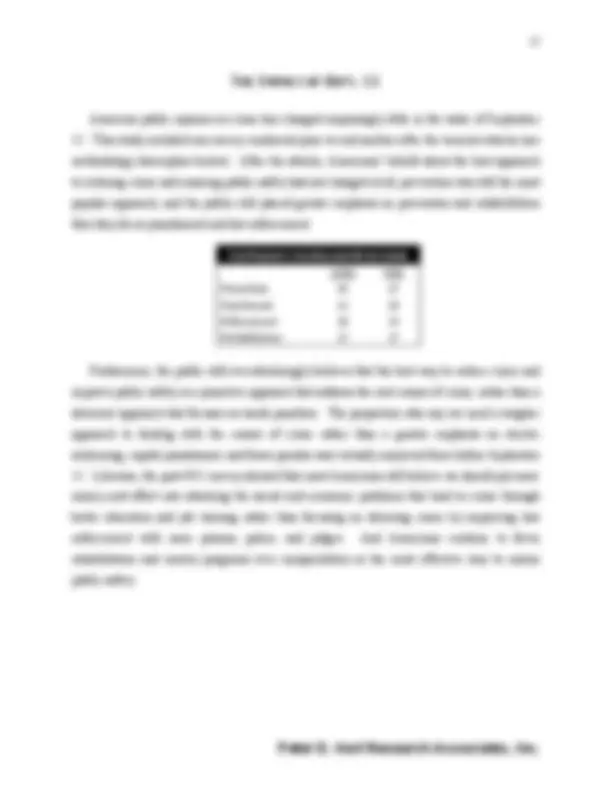
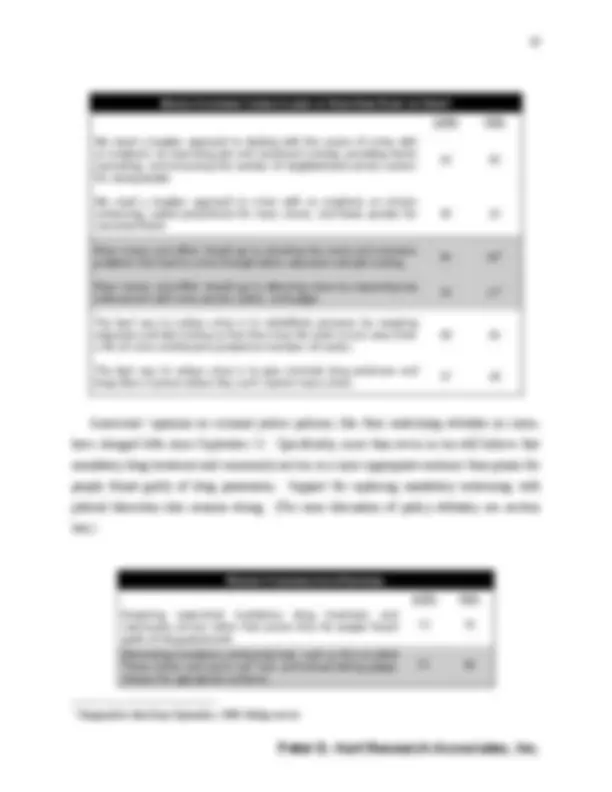
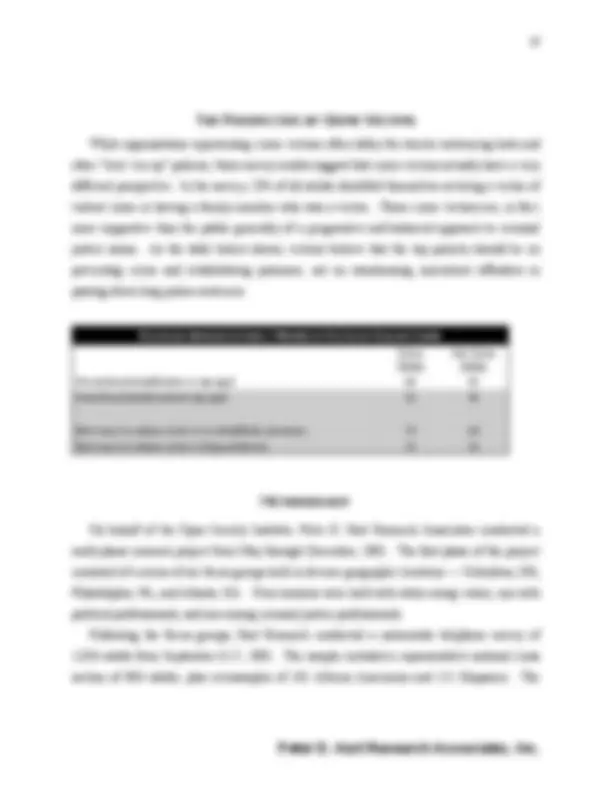



Study with the several resources on Docsity

Earn points by helping other students or get them with a premium plan


Prepare for your exams
Study with the several resources on Docsity

Earn points to download
Earn points by helping other students or get them with a premium plan
Community
Ask the community for help and clear up your study doubts
Discover the best universities in your country according to Docsity users
Free resources
Download our free guides on studying techniques, anxiety management strategies, and thesis advice from Docsity tutors
Insights into the changing public opinion on criminal justice policies in the US, with a focus on the preference for addressing the causes of crime through education, job training, and rehabilitation over stricter sentencing and longer prison terms. The data is based on surveys conducted by Peter D. Hart Research Associates between 1994 and 2001.
What you will learn
Typology: Lecture notes
1 / 21

This page cannot be seen from the preview
Don't miss anything!














Peter D. Hart Research Associates, Inc. for The Open Society Institute
SECTION O NE : THE PUBLIC ’ S CHANGING VIEW OF CRIME
Public opinion on crime and criminal justice has undergone a significant transformation over the past few years. Support for long prison sentences as the primary tool in the fight against crime is waning, as most people reject a purely punitive approach to criminal justice. Instead, the public now endorses a balanced, multifaceted solution that focuses on prevention and rehabilitation in concert with other remedies. Evidence of this new perspective is visible in three public opinion research findings: (1) more than in the past, the public believes we should be addressing the underlying causes of crime rather than the symptoms of crime; (2) Americans now see prevention as their top priority for fighting crime, far ahead of punishment or enforcement; and (3) Americans are reconsidering the wisdom of harsh prison sentences as the centerpiece of the nation’s crime strategy, especially for nonviolent offenders. These are the principal conclusions from two national telephone surveys and six focus groups conducted by Peter D. Hart Research Associates on behalf of the Open Society Institute.
Attack the Causes Not the Symptoms
Public opinion has shifted substantially on the question of whether to take a preemptive approach to crime reduction by addressing the underlying causes of crime, or whether to focus on deterrence through stricter sentencing. In 1994, Americans were divided on this question, when 48% favored addressing the causes of crime and 42% preferred the punitive approach. Since then, there has been significant movement toward the progressive view. The public now favors dealing with the roots of crime over strict sentencing by a two to one margin, 65% to 32%.
“I believe that strong communities are safe communities.” – Antique dealer, Columbus, OH. “I think you need a combination of tax incentives from big corporations to invest in poor neighborhoods and you get the personnel, good personnel, which means teachers, social workers, doctors.” – Graphic designer, Atlanta, GA.
Prevention is Nation’s #1 Criminal Justice Goal
Among the various approaches to dealing with crime, Americans express a clear preference for prevention as the best strategy. Indeed, thirty-seven percent believe that prevention should be the highest priority, ahead of punishment (20%), enforcement (19%) and rehabilitation (17%). In combination, prevention and rehabilitation (54%) garner far more support than do the approaches of punishment and enforcement (39%). Significantly, the pre- and post-9/11 results to this question are virtually identical. Additionally, 76% believe that the country currently puts too little emphasis on prevention (just 3% say we focus too heavily on prevention). Progressive solutions receive strong support among several demographic groups. Hispanics are among the strongest supporters of prevention, while African Americans also place a great deal of emphasis on efforts to rehabilitate prisoners. In fact, African American men rate rehabilitation as their top priority. Education is also a salient factor: college graduates are twice as likely to choose the progressive approaches (65%) over the punitive approaches (30%), whereas those with a high school degree or less are divided in their preference (46% prevent/rehabilitate, 45% enforce/punish).
TOP P RIORITY FOR DEALING WITH CRIME All Whites Hispanics Blacks Prevention , such as education and youth programs 37%^ 34%^ 46%^ 38% Rehabilitation , such as education and job training for prisoners 17%^ 15%^ 13%^ 34% Total prevention/rehabilitation (^) 54% 49% 59% 72% Punishment , such as longer sentences and more prisons 20%^ 22%^ 19%^ 10% Enforcement , such as putting more police officers on the streets 19%^ 20%^ 19%^ 15% Total punishment/enforcement (^) 39% 42% 38% 25%
Americans over 65 years are among those who take a more conservative view of crime (48% prevent/rehabilitate, 43% enforce/punish). Republicans (42%, 50%) put priority on punishment and enforcement, but Independents (55%, 36%) agree with Democrats (62%, 33%) in placing greater emphasis on prevention and rehabilitation.
“It’s always very popular politically to say, ‘I put them away.’ Who wants to deal with a criminal? I don’t want to deal with a criminal. Get them out of my face, put them behind bars. But that doesn’t address the problem. It satisfies my anger, nothing else.” – Retired teacher, Philadelphia, PA. “I had prevention as the number one [priority] because I think if you do a really good job of prevention the rest will fall in place.” – Homemaker, Columbus, OH. Preventing crime is clearly the public’s first priority, but that still leaves a question of what to do with people after they break the law. Americans answer this question in two ways. First, they support rehabilitation over long prison sentences as the best method of handling offenders. Second, they support alternative punishments, other than prison, for people convicted of nonviolent crimes. Americans strongly favor rehabilitation and reentry programs over incapacitation as the best method of ensuring public safety. Nearly two-thirds of all Americans (66%) agree that the best way to reduce crime is to rehabilitate prisoners by requiring education and job training so they have the tools to turn away from a life of crime, while just one in three (28%) believe that keeping criminals off the streets through long prison sentences would be the more effective alternative. This idea has broad-based support, with solid majorities of whites (63% / 31%), fundamentalist Protestants (55% / 36%), and Republicans (55% / 38%) supporting rehabilitation over incapacitation as the best way to reduce crime. Interestingly, the 23% of Americans who report that they or a close family member have been the victim of a violent crime endorse rehabilitation even more strongly than the general public, by a decisive 73% to 21% margin. The public’s support for rehabilitation over incapacitation is based both on their belief in fairness and on a pragmatic sense of self-interest. Americans understand that most prisoners will be released from jail and re-enter society at some point in their lives. The public worries that if offenders are released from prison with the same skill set and job opportunities that they had before they were incarcerated, it is likely that the former prisoner will have few alternatives other
strikes” was considered a sure political winner in the early- and mid-1990s. Now we find that the public is in a different place, having serious second thoughts about employing harsh, inflexible prison sentences as its primary weapon against crime.
“The number of victimless criminals in prison is just tremendous. I'm not saying prostitution is right or drugs are right, but it seems that there are so many other worse people who are committing more violent acts. You can actually go and make sure that they're getting a fair trial by clearing out the dockets a little bit and make sure they're getting the programs here, job training or getting their GED. Putting a victimless criminal in there with other hardened criminals makes them come out as a worse person. Not only do they come out with a rap sheet, it makes it much more difficult to get a job. It just starts stacking against people. So what I think we need to get smart on crime is we need to rethink what is crime and what is not a crime.” – White swing voter, Atlanta, GA. “All we’re doing is throwing them in jail. I don’t think anybody is getting rehabilitated there. They’re just going in there and biding their time and leaving. To me people, especially the users of drugs, they shouldn’t be in prison. All they’re doing is taking up space. There’s got to be some place to deal just with the drug aspect of it. Keeping them away from the hardened criminals.” – White swing voter, Columbus, OH.
BEHIND THE CHANGING PERSPECTIVE
The key reason that the public has begun staking out a more progressive position on criminal justice issues is that there is widespread agreement that the nation’s existing approach to criminal justice is off-target. In recent years, policy makers have pursued a “tough on crime” strategy that focuses on deterrence and incapacitation through long sentences, in part because they perceive this approach to be the most politically appealing. However, these survey results indicate that the political conventional wisdom misjudges the mood of the voters, who now see the “lock ‘em up” strategy as having failed in crucial respects. Americans now judge the system by whether it prevents people from heading down the wrong track in the first place and whether it rehabilitates offenders who get off-track. So far, the criminal justice system does not receive high marks for achieving these new criteria.
Rejecting the Current Paradigm
In the broadest sense, Americans believe that our country’s strategy on crime and criminal justice has failed. A majority of all adults (54%) say the nation’s approach to crime is off on the wrong track, while just more than a third (35%) say we are headed in the right direction. There is broad consensus about the failure of the criminal justice system, as majorities or pluralities of most groups assert that our approach to crime is on the wrong track.
THE N ATION’ S APPROACH TO CRIME
All Whites Blacks Hisp.
Hisp. 18-
Hisp. 40+ Dems^ Reps Right direction 35 35 29 47 51 38 34 44 Wrong track 54 54 63 42 39 51 55 49
“The system’s broke. People know it’s broke. They don’t know, and there is no kind of conclusion of how to change it yet. But, and that’s the difference, is that you cannot just rely on the balance of justice and say, it works, all we’ve got to do is arrest them, and everything else will be taken care of.” – Public affairs consultant, Columbus, OH.
View of Nation’s Approach to Crime
11%
54%
Not sure
existing rehabilitation programs have been successful (only 2% describe these efforts as very successful). Indeed, both survey respondents and focus group participants strongly believe that today’s prisons are no more than “warehouses,” providing little or no rehabilitation or reentry programs, that instead simply store criminals for a period of time and then dump them back on the street, no different than when they were first incarcerated. The idea of simply incapacitating people who commit crimes does not meet the public’s standard for dealing with offenders. “I also think that they're just housing them. You go to jail, you get out. You're not solving the problem. By the time they get out they've just learned more tricks from all the other criminals. They just come out worse.” – Purchaser, Atlanta, GA. “You just sort of hold them in limbo for five, ten, fifteen, twenty years and then put them right back where they started. I mean, we have to, by law, parole them back to the same place that their charges originated from. So we’re putting them right back in the same environment. We’re putting them right back in the same family problems. We’re putting back in the same low employment or distressed neighborhoods with a couple extra strikes against them than they had before they started. I think there should be more of a balance in recognizing that there is the punishment, but at some point we have to live next door to these folks again, and they have to reintegrate. We need to be prepared for that or we’re just going to continue to perpetuate a population that goes in and out of prison. And if we’re willing to pay for that and be the victims of their crimes, fine, but otherwise we might need to come up with a better idea.” – Research analyst, Philadelphia, PA.
Success of Efforts to Rehabilitate Prisoners
8% (^) 32%
33%
25%
2%
Very Successful Not sure (^) Somewhat Successful
Somewhat Unsuccessful
Very Unsuccessful
Following their shifting attitudes on crime, Americans support criminal justice policies that reflect their new perspective. The public’s new agenda reflects a common-sense approach to dealing with crime and a rejection of policies that rely exclusively on incapacitation and deterrence. Americans support initiatives that they believe will be most effective at reducing crime and improving public safety, which means seeking a balanced approach that combines prevention, punishment, and rehabilitation.
ALTERNATIVES TO PRISON
There is a broad consensus that the war on drugs has failed and that it is time for a new approach to dealing with drug addiction. Nationwide, three quarters (76%) favor a proposal requiring supervised mandatory drug treatment and community service rather than prison time for people convicted of drug possession. (Note: this policy was passed by California voters as Proposition 36 in 2000.) This progressive approach even extends to minor drug sellers—71% favor a policy that would mandate drug treatment and community service rather than prison for people found guilty of selling small amounts of drugs. Both of these proposals garner support from large majorities of all segments of the population.
Support for Mandatory Supervised Treatment for Drug Crimes
76%
4% 20%
SomewhatStrongly/ Favor
Somewhat/Strongly Not sure Oppose
Treatment/Community Service for^ Requiring Mandatory Selling Small Amounts
27%
2%
71%
Somewhat/Strongly Oppose
SomewhatStrongly/ Favor
Requiring Mandatory Treatmentfor Possession
Not sure
More broadly, three-quarters (75%) of all adults favor sentencing nonviolent offenders to supervised community service or probation instead of imprisonment, including 41% who strongly favor this proposal. A similar proportion (73%) approves of sentencing nonviolent offenders to serve prison time in the evening or on weekends so they can keep working at their job during the day (40% strongly support). A majority of Americans (63%) also favors simply reducing prison sentences for people convicted of nonviolent crimes, although support for this measure is considerably weaker: only 26% strongly favor the proposal. There is broad support for all three of these measures.
REFORMING M ANDATORY SENTENCING
Perhaps the most surprising finding regarding criminal justice policies is the degree to which the public has now turned against previously-popular mandatory sentences, such as “three strikes” provisions. This is an area that links together the public’s changing perceptions of rehabilitation and drug policies, and reflects the public’s growing doubts about the “lock ‘em up” approach to crime. Fifty-six percent of adults now favor the elimination of three strikes policies and other mandatory sentencing laws, and instead letting judges choose the appropriate sentence, while just 38% are opposed. Reform receives especially strong support from blacks (64% favor), but also from a majority of whites (54%) and Hispanics (57%). Significantly, majorities of Republicans (51% in favor), independents (56%), and Democrats (60%) all favor elimination of three strikes laws. This represents a substantial shift from the mid-1990s, when a majority of Americans favored the mandatory sentencing approach (for example, 55% said mandatory sentences were “a good idea” in a 1995 Flanagan/Longmire survey). Public understanding of the role that mandatory sentencing laws play in the imprisonment of non-violent offenders is not universal — 57% of adults are “just somewhat familiar” or “not that familiar” with mandatory sentencing laws — but appears to be growing. Participants in focus groups frequently raise mandatory sentences as an issue without prompting, invariably in a critical way. The public increasingly recognizes that a one-size-fits-all sentencing system results in lengthy sentences that are inappropriate for some offenders (especially those convicted of non-violent crimes).
Eliminating Mandatory Sentences All Reps Ind Dems Favor 56 51 56 60 Oppose 38 45 35 34
The public has not reached a solid consensus behind repealing mandatory minimums. Nonetheless, support for mandatory minimums has eroded dramatically since the mid-1990s, and Americans are certainly now willing to rethink these policies. Reforming mandatory minimums thus appears to be an emerging opportunity for criminal justice reformers.
“I think when you take discretion away from a judge it’s pretty dangerous. I don’t think that, when you tie a judge’s hands and say, ‘sorry, this is what you have to do,’ then he doesn’t even need to be there. It’s pointless.” – Antique dealer, Columbus, OH. “I have a problem with saying we’re going to wholesale warehouse all these criminals. I think you’ve got to look at, and I think the judge has to have the latitude to look at the particular offense and the particular person, and what could he do best for that person.”
A failure to rehabilitate prisoners is seen as a major shortcoming of the U.S. prison system. The public believes that the corrections system currently does very little in the way of “correcting” criminal behavior, and that most prisoners are released with the same lack of education and job skills that often leads to crime in the first place. Consequently, there is near unanimous support for expanding rehabilitation and re-entry programs for prisoners that would help them get a job and turn away from crime after they are released. Indeed, education and job training programs for prisoners are the most popular policy proposals tested. Three-quarters of the public favors early release for prisoners who participate in rehabilitation programs and are considered a low risk for further offenses. A smaller majority also favors restoring basic rights to prisoners, such as voting rights or the ability to hold a drivers license, after they have completed their sentence.
keep young people off the streets, and expanding economic development in poor neighborhoods to create more jobs. In fact, several groups rank after-school activities ahead of values education as the best way to prevent crime, including Hispanics (37% after-school activities, 30% values education), 18- to 34-year olds (35%, 28%), and people with incomes less than $30,000 (36%, 31%).
“Especially with inner city kids or kids that don’t have parental support after school, after-school programs I think should be a top priority. And a lot of these after-school programs don’t get constant funding that they can rely on…they’re always begging for money…Some communities have them. Some don’t. That’s my point. Especially in communities where you need it the most you usually don’t find it.” – Homemaker, Columbus, OH. “Responsibility and teaching your children responsibility. I think that has the biggest impact on a child growing up.” – Nurse, Atlanta, GA.
BUDGET SHORTFALLS AND PRISON SPENDING
Reduced tax revenues due to the weakening economy is forcing legislators in many states to make difficult choices in order to balance their states’ budgets. Lawmakers are always reluctant to cut spending on popular programs, but even more hesitant to raise taxes. Given a choice of six budget areas that could be reduced to help states balance the budget, the public places spending on prisons (28%) at the top of their list, tied with transportation. Americans would take
13%
15%
15%
23%
29%
37%
Most Effective Steps to Prevent Crime (% saying step is one or two of the most effective) Teaching young people personal responsibility and moral values in school programs to help keep youth off the streetsHaving after-school/late-night recreation Increasing business/ economic devel. in poorneighborhoods to create living wage jobs Providing one-on-one mentoring andcounseling for at-risk youth Improving public education for poor children Providing treatment for people who areaddicted to drugs or alcohol
the budget ax to prisons much more quickly than to child care for working families (10%), security against terrorism (10%), education and job training (5%), or health care (2%). Hispanics (37%) and blue-collar workers (37%) are among the strongest supporters of cutbacks in prison spending. And younger adults, age 18- 34, are far more supportive of reductions in prison spending (43%) than are older Americans, age 65 and over (16%). Beyond simple across-the-board reductions in prison spending, Americans also support long- term strategies to save money by reducing our reliance on prisons. Indeed, more than three quarters (77%) of all Americans believe that expanding after-school programs and other crime prevention programs would save money in the long run by reducing the need for prisons, and the same proportion agree that state governments can save money by placing nonviolent drug offenders in treatment programs. Despite some demographic variations, large majorities of all groups support both of these approaches to reducing prison spending.
P ERCENT AGREEING WITH E ACH S TATEMENT All White Black Hisp. Dem Ind Rep 18-49 50+ Expanding after-school programs and other crime prevention programs would save money in the long run by reducing the need for prisons
77 75 89 86 86 78 67 83 69
State governments can save money by placing nonviolent drug offenders in treatment programs, which cost less than keeping people in prison
77 75 83 84 87 76 65 81 71
2 %
5 %
1 0 %
1 0 %
2 8 %
2 8 %
Prisons Roads, bridges, and mass transit Child care for low-income families Security protections against terrorism Education and job training Nursing homes and health care
W HICH S TATEMENT COMES CLOSER TO Y OUR O WN P OINT OF V IEW? 12/01 9/ We need a tougher approach to dealing with the causes of crime with an emphasis on improving job and vocational training, providing family counseling, and increasing the number of neighborhood activity centers for young people
63 65
We need a tougher approach to crime with an emphasis on stricter sentencing, capital punishment for more crimes, and fewer paroles for convicted felons
35 32
More money and effort should go to attacking the social and economic problems that lead to crime through better education and job training 66 68
2
More money and effort should go to deterring crime by improving law enforcement with more prisons, police, and judges 29 27
2
The best way to reduce crime is to rehabilitate prisoners by requiring education and job training so that they have the tools to turn away from a life of crime and become productive members of society
68 66
The best way to reduce crime is to give criminals long sentences and keep them in prison where they can't commit more crimes 27 28
Americans’ opinions on criminal justice policies, like their underlying attitudes on crime, have changed little since September 11. Specifically, more than seven in ten still believe that mandatory drug treatment and community service is a more appropriate sentence than prison for people found guilty of drug possession. Support for replacing mandatory sentencing with judicial discretion also remains strong. (For more discussion of policy attitudes, see section two.)
P ERCENT FAVORING E ACH P ROPOSAL 12/01 9/ Requiring supervised mandatory drug treatment and community service rather than prison time for people found guilty of drug possession
72 76 Eliminating mandatory sentencing laws, such as the so-called “three strikes and you’re out” law, and instead letting judges choose the appropriate sentence
57 56
(^2) Comparative data from September, 2000 Gallup survey.
While organizations representing crime victims often lobby for stricter sentencing laws and other “lock ‘em up” policies, these survey results suggest that crime victims actually have a very different perspective. In the survey, 23% of all adults identified themselves as being a victim of violent crime or having a family member who was a victim. These crime victims are, in fact, more supportive than the public generally of a progressive and balanced approach to criminal justice issues. As the table below shows, victims believe that the top priority should be on preventing crime and rehabilitating prisoners, not on warehousing nonviolent offenders or passing down long prison sentences.
V ICTIM OR I MMEDIATE FAMILY MEMBER OF V ICTIM OF V IOLENT CRIME Crime Victim
Not Crime Victim Prevention/rehabilitation is top goal 60 52 Punishment/enforcement top goal 31 41
Best way to reduce crime is to rehabilitate prisoners 73 64 Best way to reduce crime is long sentences 21 31
On behalf of the Open Society Institute, Peter D. Hart Research Associates conducted a multi-phase research project from May through December, 2001. The first phase of the project consisted of a series of six focus groups held in diverse geographic locations — Columbus, OH, Philadelphia, PA, and Atlanta, GA. Four sessions were held with white swing voters, one with political professionals, and one among criminal justice professionals. Following the focus groups, Hart Research conducted a nationwide telephone survey of 1,056 adults from September 6-17, 2001. The sample included a representative national cross section of 804 adults, plus oversamples of 101 African Americans and 151 Hispanics. The